November 13, 2011
Our Best Book from the Library Haul: Argus by Knudsen/Wesson
 So Argus, which was written by Michelle Knudsen and illustrated by Andrea Wesson, is another story of a misidentified egg, along the lines of The Odd Egg by Emily Gravett or Duck and Goose by Tad Hills. When it comes time to hatch chicks at school, poor Sally ends up with the odd one out. The egg hatches into what appears to be a dragon, and no one takes much notice, as poor Sally struggles to care for her most unruly “chick.” In the end, she learns that it’s not so bad to stand out from the crowd, but for me, the story’s chief appeal lies the narrative involving Sally’s teacher Mrs. Henshaw, who never bats an eye at the dragon in her room, even when she’s forced to leap atop desks to prevent it from eating her students. And anyone who dares to cross her is stopped with the teacher’s signature phrase, “Don’t be difficult.” And really, who can argue with that?
So Argus, which was written by Michelle Knudsen and illustrated by Andrea Wesson, is another story of a misidentified egg, along the lines of The Odd Egg by Emily Gravett or Duck and Goose by Tad Hills. When it comes time to hatch chicks at school, poor Sally ends up with the odd one out. The egg hatches into what appears to be a dragon, and no one takes much notice, as poor Sally struggles to care for her most unruly “chick.” In the end, she learns that it’s not so bad to stand out from the crowd, but for me, the story’s chief appeal lies the narrative involving Sally’s teacher Mrs. Henshaw, who never bats an eye at the dragon in her room, even when she’s forced to leap atop desks to prevent it from eating her students. And anyone who dares to cross her is stopped with the teacher’s signature phrase, “Don’t be difficult.” And really, who can argue with that?
November 6, 2011
Our Best Book from the Library Haul: In the Meadow by Hilde Heyduck-Huth
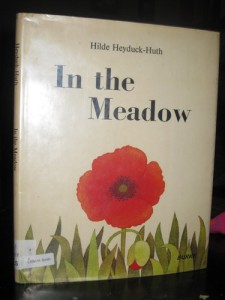 There wasn’t an obvious candidate for our Best Book this week, and this aged book, which was translated from German by Patricia Crampton, did not seem like an obvious contender. But you never know with Best Books really, and it’s anybody’s guess how children will respond. Halfway through our first reading of In the Meadow, the story about a dung beetle navigating a forest of grass, Harriet was absolutely captivated.When the beetle encountered his ladybug relatives,
There wasn’t an obvious candidate for our Best Book this week, and this aged book, which was translated from German by Patricia Crampton, did not seem like an obvious contender. But you never know with Best Books really, and it’s anybody’s guess how children will respond. Halfway through our first reading of In the Meadow, the story about a dung beetle navigating a forest of grass, Harriet was absolutely captivated.When the beetle encountered his ladybug relatives,  Harriet insisted on digging her stuffed ladybug out of her toybox. “Ladybugs are a kind of beetle,” I explained to her, but she heard it differently, and has been telling us ever since how her ladybug is a “kind-of beetle”. The illustrations in this book are detailed and beautiful. Hilde Heyduck-Huth has a website (in German) and from the links on this page you get a sense of the fascinating things she’s been up to in her illustration career (inc. an edition of Kahil Gibran’s The Prophet).
Harriet insisted on digging her stuffed ladybug out of her toybox. “Ladybugs are a kind of beetle,” I explained to her, but she heard it differently, and has been telling us ever since how her ladybug is a “kind-of beetle”. The illustrations in this book are detailed and beautiful. Hilde Heyduck-Huth has a website (in German) and from the links on this page you get a sense of the fascinating things she’s been up to in her illustration career (inc. an edition of Kahil Gibran’s The Prophet).
October 27, 2011
Our Best Book from the library haul: Once Upon A Golden Apple
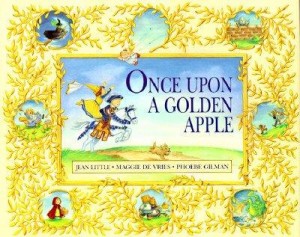 It was meant to be, really. A team of Canadian kid-lit legends Jean Little and Phoebe Gilman could only ever have been a success. Co-Author Maggie de Vries too– I’d read her memoir Missing Sarah years ago, and she’s had a successful career writing for children as well. But I am really baffled as to how it’s taken me so long to discover Once Upon a Golden Apple.
It was meant to be, really. A team of Canadian kid-lit legends Jean Little and Phoebe Gilman could only ever have been a success. Co-Author Maggie de Vries too– I’d read her memoir Missing Sarah years ago, and she’s had a successful career writing for children as well. But I am really baffled as to how it’s taken me so long to discover Once Upon a Golden Apple.
The very best book from the library in a bumper week of very good books from the library, and as soon as we began to read it, we just knew. It begins with a father telling his children a story, deviating from the familiar tropes much to their chagrin. “Once upon a golden apple?” “No!” the children shout. “Once upon a singing fiddle?” “No, no, no, no, no!” With each preposterous suggestion, the children become more and more agitated, and just when they think they’ve got their dad back on track, he breaks off again: there lived Goldilocks and the Seven Dwarfs? The princess kissed Humpty Dumpty? Who turned into a gingerbread boy? “No, no, no, no, no!”
Gilman’s children are adorable and Jillian Jiggs-ish, and we like the sausage-stealing dog that the storytellers are too en-rapt to notice. de Vries and Little finally manage to get the tale told, though not before making ridiculous suggestions that Harriet finds hilarious, and loves most of all because it’s always fun to be in on the joke, especially when you’re aged two.
October 23, 2011
New Kids Books We've Been Enjoying
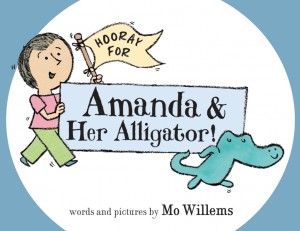 Hooray for Amanda and her Alligator by Mo Willems: Willems is the best part of parenthood, his stories of Elephant & Piggie, Knuffle-Bunny and that notorious Pigeon never failing to delight, but I think that Amanda and her Alligator is my favourite yet. Amanda arrives home from the library with a stack of books, and her toy alligator has been waiting to play with her. Over 6 1/2 chapters, Amanda reads though her library stack (mostly nonfiction– my favourite is Climbing Things for Fun and Profit, or maybe Build It Yourself: Jet Packs!), and sets upon adventures with Alligator without ever leaving her room. The drawings are clear and simple, the stories too, and they’re heartwarming (though not ickily so) as they are funny.
Hooray for Amanda and her Alligator by Mo Willems: Willems is the best part of parenthood, his stories of Elephant & Piggie, Knuffle-Bunny and that notorious Pigeon never failing to delight, but I think that Amanda and her Alligator is my favourite yet. Amanda arrives home from the library with a stack of books, and her toy alligator has been waiting to play with her. Over 6 1/2 chapters, Amanda reads though her library stack (mostly nonfiction– my favourite is Climbing Things for Fun and Profit, or maybe Build It Yourself: Jet Packs!), and sets upon adventures with Alligator without ever leaving her room. The drawings are clear and simple, the stories too, and they’re heartwarming (though not ickily so) as they are funny. 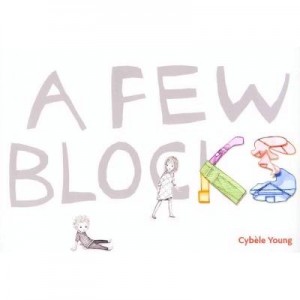
A Few Blocks by Cybele Young: There is nothing simple about the illustrations of Cybele Young’s book A Few Blocks, in which imagination transforms the few blocks it takes to walk to school into a rich fantasy world. Ferdie doesn’t want to go school, but his sister Viola coaxes him along the way by creating adventure out of the ordinary, just as Young herself does through collage of her drawings which transform ordinary bits of neighbourhood into a giant sailing ship, a knight’s battleground, a superhero’s stomping ground.
 A Daisy is a Daisy is a Daisy (except when it’s a girl’s name) by Linda Wolfsgruber: A Daisy… is a strange book that will probably appeal most to anyone with a flower name, or those of us who read baby name books as a pasttime. Gorgeously illustrated, Wolfsgruber shows that girls all over the world are named after flowers, and in all kinds of different languages. In Greek, Ianthe means violet, and she is Jolan in Hungarian, and Yolanda in Spanish. In Dutch, Mirte means Myrtle, she’s Hadassah in Hebrew, and Mirta in Spanish and Greek. “And Chloe is a very young sprout…”
A Daisy is a Daisy is a Daisy (except when it’s a girl’s name) by Linda Wolfsgruber: A Daisy… is a strange book that will probably appeal most to anyone with a flower name, or those of us who read baby name books as a pasttime. Gorgeously illustrated, Wolfsgruber shows that girls all over the world are named after flowers, and in all kinds of different languages. In Greek, Ianthe means violet, and she is Jolan in Hungarian, and Yolanda in Spanish. In Dutch, Mirte means Myrtle, she’s Hadassah in Hebrew, and Mirta in Spanish and Greek. “And Chloe is a very young sprout…”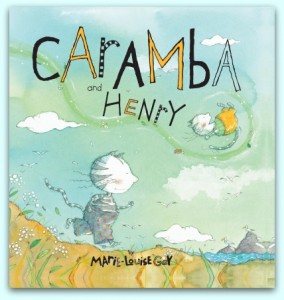
Caramba and Henry by Marie-Louise Gay: “Stella and Sam?” said Harriet the first time she saw this book, and it doesn’t even matter that it’s not, because Marie-Louise Gay is always good. Though I don’t get him, Caramba, the cat who can’t fly. “But cats can’t fly!” I keep protesting, and people shout back at me, “That’s the point. Isn’t it awesome?” I’m not sure, but Harriet has never batted an eye, the story is great, the full page spreads absolutely breathtaking in their scope. Marie-Louise Gay is a treasure.
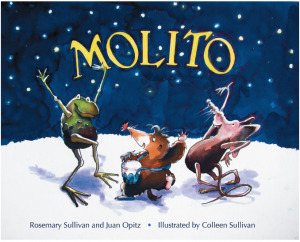 Molito by Rosemary Sullivan and Juan Optiz, illustration by Colleen Sullivan: Rosemary Sullivan is a friend of mine, and Harriet loves drums, so we were set to love this book from the get-go. The story of a little mole who dares to climb up from the underworld and discovers a whole other world out there of music, dancing and light. But losing himself to this world would require losing the friends and music he made in his life underground, so Molito seeks a way to make a connection between the two. “Above and below/ In the dark and the light/ Upside down and upside right/ Below your feet and above your head/ There’s just one world./ There’s just one world.” Colleen Sullivan’s illustrations are delightful in their detail, and the book also comes with a CD of Molito’s music.
Molito by Rosemary Sullivan and Juan Optiz, illustration by Colleen Sullivan: Rosemary Sullivan is a friend of mine, and Harriet loves drums, so we were set to love this book from the get-go. The story of a little mole who dares to climb up from the underworld and discovers a whole other world out there of music, dancing and light. But losing himself to this world would require losing the friends and music he made in his life underground, so Molito seeks a way to make a connection between the two. “Above and below/ In the dark and the light/ Upside down and upside right/ Below your feet and above your head/ There’s just one world./ There’s just one world.” Colleen Sullivan’s illustrations are delightful in their detail, and the book also comes with a CD of Molito’s music. 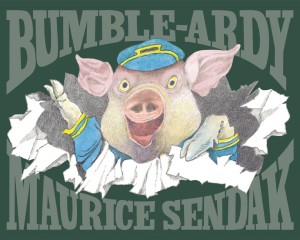
Bumble-Ardy by Maurice Sendak: I’m more confused by Maurice Sendak than I am by Caramba, actually, but my appreciation for Sendak’s new book Bumble-Ardy was underlined when I read his interview in The Paris Review. Harriet just likes the pigs, the birthday party and the pictures. The rhyme is a bit ripped off from Ludwig Bemelmans, reminding us of a someone we once knew who left the house at half-past nine in rain or shine, but I’m less confused than I was with Outside Over There, and there is depth here that reader young and old can tumble into and wander around in. Every time I read it, I appreciate it more.
October 20, 2011
Our Best Book from the library haul: Ira Sleeps Over by Bernard Waber
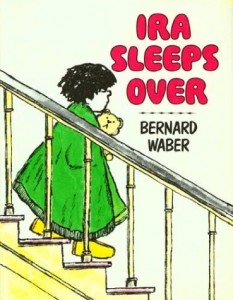 We’re having a bit of an affair with Bernard Waber’s Lyle the Crocodile books, which are so good, and Harriet loves them. Though they’re a bit long, and I’m not sure every toddler would have the patience, so I was delighted when we took out a new book by Waber, Ira Sleeps Over, and discovered that here was a less text-laden book that I could heartily recommend.
We’re having a bit of an affair with Bernard Waber’s Lyle the Crocodile books, which are so good, and Harriet loves them. Though they’re a bit long, and I’m not sure every toddler would have the patience, so I was delighted when we took out a new book by Waber, Ira Sleeps Over, and discovered that here was a less text-laden book that I could heartily recommend.
I love these ’60s/70s’ children’s books (Waber reminds me of Louise Fitzhugh and Judith Viorst), their sharpness, and their irreverance. Plus, Waber is an author/illustrator, and the best of these people can elevate the picture book to a whole other level. Must confess up front though that I am disproportionately amused that this book contains the line, “That night, Reggie showed me his junk.” But that’s only because you’re the one with the sick mind.
Ira has been invited to a sleepover at his friend Reggie’s house. He’s excited, but a little nervous, and he goes back and forth between these emotions in passages with his parents and meddlesome sister– the repetitive language will especially appeal to young readers. When Ira wonders if he should bring his teddy bear with him? Would Reggie laugh?: “”He won’t laugh,” said my mother. “He won’t laugh,” said my father. “He’ll laugh,” said my sister.”” I particularly love the family dynamics, very Free to Be You and Me with Mom and Dad making dinner together, both parents pursuing interests beyond their parental roles as Dad practicising the cello in the evening, and Mom hides behind the newspaper.
Eventually the sleepover arrives, and Reggie and Ira have fun together. Reggie shows Ira his junk collection in a fabulous two page spread that might have inspired a young Marthe Jocelyn to go on to write Hannah’s Collections. The boys start to tell ghost stories, and the moral of the book turns out to be that a need for comfort is universal, that teddy bears are much less controversial than a small boy might think.
October 17, 2011
Our visit to Little Island Comics
 By pure coincidence, this is my third post in a row dealing with islands and oceans. And this is an especially joyful post because the gist of it is that a new children’s bookstore has just opened up around the corner from my house. Little Island Comics is brought to you by the people behind The Beguiling, and is the first comic book store in North America catering exclusively to children. They cater not just with comics either, but also with a wide variety of beautiful books that seem to mostly just have gorgeous illustrations in common. We stopped by on Saturday and the store was full to bursting with children of all ages (and their parents). Though the big kids in the store seemed enthralled by the wares, we also found much to choose from for the Harriet set, and settled on a Tiny Titans comic, and Maurice Sendak’s new book Bumble-Ardy. Staff were approachable, knowledgeable, and thrilled with all the activity going on in the store. And there’s bound to be more of it– Little Island Comics has a space in the back where comic workshops and other events will be conducted. Check their blog to stay abreast of happenings. We’re looking forward to our next visit!
By pure coincidence, this is my third post in a row dealing with islands and oceans. And this is an especially joyful post because the gist of it is that a new children’s bookstore has just opened up around the corner from my house. Little Island Comics is brought to you by the people behind The Beguiling, and is the first comic book store in North America catering exclusively to children. They cater not just with comics either, but also with a wide variety of beautiful books that seem to mostly just have gorgeous illustrations in common. We stopped by on Saturday and the store was full to bursting with children of all ages (and their parents). Though the big kids in the store seemed enthralled by the wares, we also found much to choose from for the Harriet set, and settled on a Tiny Titans comic, and Maurice Sendak’s new book Bumble-Ardy. Staff were approachable, knowledgeable, and thrilled with all the activity going on in the store. And there’s bound to be more of it– Little Island Comics has a space in the back where comic workshops and other events will be conducted. Check their blog to stay abreast of happenings. We’re looking forward to our next visit!
*Check out their profile from last weekend’s Globe and Mail.
October 13, 2011
Our Best Books from the library haul: Sunny et. al. Robin Mitchell and Judith Steedman
 Once again we’re cheating: these aren’t books I stumbled upon, but rather sought out after a recommendation from Sara O’Leary (whose new book When I Was Small is out next month, and whose Picture Books We Know and Love list is brilliant). Sunny (and his companions Windy, Snowy & Chinook and Foggy) are all written and illustrated by Robin Mitchell and Judith Steedman, and published by the wonderful Simply Read Books. I’ve not read Foggy yet, but the other three have been read and re-read with much delight since we borrowed them from the library last week.
Once again we’re cheating: these aren’t books I stumbled upon, but rather sought out after a recommendation from Sara O’Leary (whose new book When I Was Small is out next month, and whose Picture Books We Know and Love list is brilliant). Sunny (and his companions Windy, Snowy & Chinook and Foggy) are all written and illustrated by Robin Mitchell and Judith Steedman, and published by the wonderful Simply Read Books. I’ve not read Foggy yet, but the other three have been read and re-read with much delight since we borrowed them from the library last week.
The stories are pretty simple– Sunny begins to listen to the sounds in the city, realizes that city sounds are beautiful and celebrates them with a hootenanny. Poor Windy loses her beloved blue kite, but discovers it at the end of the story much closer to home than you might have imagined. And then Snowy and Chinook, an arctic adventure of two friends looking for a birthday gift for Tulip the Buffalo (and there is bunting!).
 These plots are perfectly complemented by simple illustrations which are not so simple when one discerns how the contents of each scene have been fashioned from ordinary objects. On top of being visually appealing, they are also pretty inspiring craft-wise, and constructed with a fabulous dose of whimsy. Also remarkable are the double page spreads in each book with simple line drawings reconstructing a map of the story so-far– little fingers will delight in tracing the dotted line and revisiting each point along the journey.
These plots are perfectly complemented by simple illustrations which are not so simple when one discerns how the contents of each scene have been fashioned from ordinary objects. On top of being visually appealing, they are also pretty inspiring craft-wise, and constructed with a fabulous dose of whimsy. Also remarkable are the double page spreads in each book with simple line drawings reconstructing a map of the story so-far– little fingers will delight in tracing the dotted line and revisiting each point along the journey.
Oh, it’s true– these are books that revel in brilliant design. The endpapers are marvelously decked with the simple line drawings from the map pages, and the underside of each dust jacket contains a hidden surprise– a recipe for pancakes, directions of kite building, instructions for homemade musical instruments. They’re absolutely lovely, and beloved by both Harriet and I . Such a fantastic discovery, so I want to pass it on to you.
October 10, 2011
What Sally Draper must have been reading: Virginia Lee Burton and Mad Men
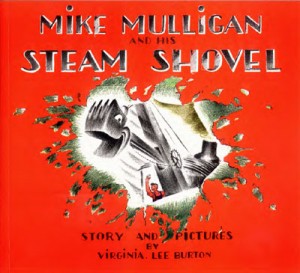 Virginia Lee Burton’s father was an engineer, and her mother was an artist, which is probably a surprise to nobody familiar with her work. Burton’s early books (Choo Choo, Mike Mulligan and His Steam Shovel, Katy and the Big Snow) are celebrations of man’s power to harness his environment with the use of technology, Burton’s vivid illustrations investing her fascinating machines with life and personality. Even 80 years after the publication of Mike Mulligan and His Steam Shovel, that steam shovel Mary-Anne appeals to young readers, and part of that timelessness is that Mary-Anne’s story of technological prowess (she could dig as much in a day as a hundred men in a week) was already about nostalgia even when the book was new. Burton’s work does not become dated, because within it she has acknowledged the passage of time. Mary-Anne was already the relic of a dying age, steam shovels being replaced by diesel-powered diggers, and Burton showed even as she glorified technology that progress did not necessarily lead to better.
Virginia Lee Burton’s father was an engineer, and her mother was an artist, which is probably a surprise to nobody familiar with her work. Burton’s early books (Choo Choo, Mike Mulligan and His Steam Shovel, Katy and the Big Snow) are celebrations of man’s power to harness his environment with the use of technology, Burton’s vivid illustrations investing her fascinating machines with life and personality. Even 80 years after the publication of Mike Mulligan and His Steam Shovel, that steam shovel Mary-Anne appeals to young readers, and part of that timelessness is that Mary-Anne’s story of technological prowess (she could dig as much in a day as a hundred men in a week) was already about nostalgia even when the book was new. Burton’s work does not become dated, because within it she has acknowledged the passage of time. Mary-Anne was already the relic of a dying age, steam shovels being replaced by diesel-powered diggers, and Burton showed even as she glorified technology that progress did not necessarily lead to better.
But the pastoral age that Mike Mulligan… hearkens back to is a pretty curious one. Children have always loved this book because children are fascinated by machinery and learning how things work (Burton: “Children have an avid appetite for knowledge. They like to learn, provided that the subject matter is presented to them in an interesting way”), but for an adult-reader to understand Mary-Anne as the story’s heroine represents a significant departure from how we in the 21st century have come to understand our relationship to the environment. Mary-Anne who can level hills to make roads for automobiles to drive on, and dig holes to turn grassland into skyscrapers, and is powered by filthy coal– that Burton’s steam shovel continues to be a lovable storybook character is a testament to the enduring qualities of her book as a whole.
Mike Mulligan was published in 1939, and in 1942, Burton published her most celebrated book, The Little House, which won the 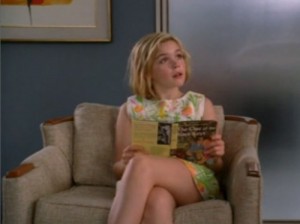 Caldecott Award that year (whose ceremony, it is noted in Barbara Elleman’s fascinating biography Virginia Lee Burton: A Life in Art, was attended by Lillian Smith, president of the Children’s Library Association and head of children’s services at the Toronto Public Library). And from these dates and these books’ acclaim, we can only assume that both found a place within the personal library of Sally Draper, who was born in 1955. Unlike her parents, Sally is rarely seen reading (until Season 4 when she’s spotted with a Nancy Drew), so the contents of her early library can only be inferred, but if the connections between Burton’s world and the Man Men universe are any indication, these books should be an essential part of any Mad Men reading list.
Caldecott Award that year (whose ceremony, it is noted in Barbara Elleman’s fascinating biography Virginia Lee Burton: A Life in Art, was attended by Lillian Smith, president of the Children’s Library Association and head of children’s services at the Toronto Public Library). And from these dates and these books’ acclaim, we can only assume that both found a place within the personal library of Sally Draper, who was born in 1955. Unlike her parents, Sally is rarely seen reading (until Season 4 when she’s spotted with a Nancy Drew), so the contents of her early library can only be inferred, but if the connections between Burton’s world and the Man Men universe are any indication, these books should be an essential part of any Mad Men reading list.
Part of the appeal of both Mike Mulligan and Mad Men is our own nostalgia, but the nostalgia already implicit within these works’ conception of modernity makes our own present ring doubly hollow. In both works, the Future is now, and the present is shining, but something essential has been irrevocably lost, and it has been too late to turn back forever now.
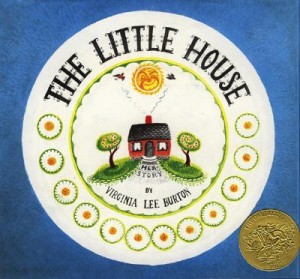 Modernity is symbolized by the city in Mad Men, and also in Burton’s work, no more so than in The Little House. In both works, the city is to be escaped from, its edges a pastoral idyll, though in both works, the city is creeping. In Mad Men, this is shown by suburban life’s failure to be protection enough from the vices and sordidness the city entails. Even in Arcadia (ie Ossining NY), there is infidelity, family violence, divorce, and women lock themselves in the house all day, drinking too much and smashing chairs up. The outside world is brought in every night by the dad in his hat coming home on the train, and by the television’s incessant blare.
Modernity is symbolized by the city in Mad Men, and also in Burton’s work, no more so than in The Little House. In both works, the city is to be escaped from, its edges a pastoral idyll, though in both works, the city is creeping. In Mad Men, this is shown by suburban life’s failure to be protection enough from the vices and sordidness the city entails. Even in Arcadia (ie Ossining NY), there is infidelity, family violence, divorce, and women lock themselves in the house all day, drinking too much and smashing chairs up. The outside world is brought in every night by the dad in his hat coming home on the train, and by the television’s incessant blare.
The creeping is literalised in Burton’s The Little House, which sits contentedly on its hill as the sun goes up and down, and as the seasons change. And then the lights of the city began to seem closer, and roads appear (courtesy of that same steam shovel we know so well from Mike Mulligan, as Harriet is always delighted to point out). There are new houses, and then the buildings around the house grow higher, and a subway is dug underneath, and trams run back and forth, and eventually the house is left abandoned and unloved in the middle of an urban wasteland. (And in this book, indeed, Burton has presaged and synthesized the ideas of Rachel Carson and Jane Jacobs).
But the book’s conclusion is as curious as is Mary-Anne’s status as hero instead of villain. The story of The Little House is resolved when a great-great grandaughter of the man who’d built the house discovers the place in its derelict state, and decides to move it back out to the countryside. Traffic is halted as the house is lifted up from its foundations and placed on a truck, then driven down a big road, then a small road, and eventually the house is settled down on a little hill much like the one it once called home (before that first hill was levelled by a steam shovel). Same apple trees and flowers, and the house can see the sky again, the sunrise in the morning, the moon shining high at night. “The stars twinkled all around her…/ A new moon was coming up…/ It was Spring…/ and all was quiet and peaceful in the country.”
The first few times I read this book as an adult, I figured the moral had something to do with white flight, and the death and death of the 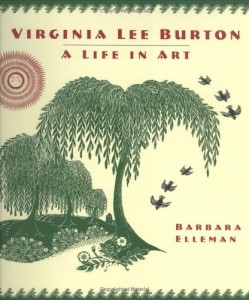 American city. Until I realized that Burton hadn’t presaged Carson/Jacobs so much, and then I thought about the book in the context of its own time, and Mad Men’s. The story’s point, according to Elleman’s book, is that “the further away we get from nature and the simple way of life the less happy we are.” It is a story of the environment with man still at its centre, and with this notion of the city as a place to move away from is an understanding that the space “away out there” is infinite, inexhaustible. (See Kathryn Davis’s Hell and the spaces at the back of medicine cabinets for razor blade disposal in the mid 20th century house– that throwing something “away” was to make it disappear.)
American city. Until I realized that Burton hadn’t presaged Carson/Jacobs so much, and then I thought about the book in the context of its own time, and Mad Men’s. The story’s point, according to Elleman’s book, is that “the further away we get from nature and the simple way of life the less happy we are.” It is a story of the environment with man still at its centre, and with this notion of the city as a place to move away from is an understanding that the space “away out there” is infinite, inexhaustible. (See Kathryn Davis’s Hell and the spaces at the back of medicine cabinets for razor blade disposal in the mid 20th century house– that throwing something “away” was to make it disappear.)
In “The Gold Violin” (Mad Men, Season 2), the Drapers retreat further from urban/suburban life by partaking in a rare family outing, a picnic (although they get there in a brand new Cadillac, so modernity has certainly not been left behind). At the end of the picnic (which has involved smoking while horizontal and peeing behind trees), Betty Draper picks up the picnic blanket and shakes away accumulated rubbish, letting it fall down onto the grass where she’ll leave it.
As in Burton’s The Little House, the world away out there is still ours for the taking, to be used and made noble by our relationship to it.
October 6, 2011
Our Best Book from the Library Haul: Russell Hoban's A Birthday for Frances
 It’s probably only been a month since we became acquainted with Russell Hoban’s Frances books, but I feel like she’s been a part of our lives forever. She was fast beloved, and my only complaint is that some of her books are a little bit long, which is a problem, you see, because I never end up reading one less than three times in a row. Harriet’s attention rarely wanders, however, and I think we’ve found our favourite Frances yet with A Birthday for Frances. The story of an older sister (who just happens to be a badger) upset with the attention being paid to little sister Gloria who’s on the verge of turning two. I love the Frances books because Frances really battles her demons, her worst self, and she shows that doing the right thing is so hard (and more over, she doesn’t even always do the right thing). For a badger, she’s one of the most realistically drawn, complex characters I’ve ever encountered in a picture book.
It’s probably only been a month since we became acquainted with Russell Hoban’s Frances books, but I feel like she’s been a part of our lives forever. She was fast beloved, and my only complaint is that some of her books are a little bit long, which is a problem, you see, because I never end up reading one less than three times in a row. Harriet’s attention rarely wanders, however, and I think we’ve found our favourite Frances yet with A Birthday for Frances. The story of an older sister (who just happens to be a badger) upset with the attention being paid to little sister Gloria who’s on the verge of turning two. I love the Frances books because Frances really battles her demons, her worst self, and she shows that doing the right thing is so hard (and more over, she doesn’t even always do the right thing). For a badger, she’s one of the most realistically drawn, complex characters I’ve ever encountered in a picture book.
Love this book also for the marvelous prose as Frances sets the scene for an imaginary frend called Alice: “That is how it is, Alice,” said Frances. “Your birthday is always the one that is not now.” Or when she’s reluctantly drawn into making place cards for Gloria’s birthday table, and sings: “A rainbow and a happy tree/ Are not for Alice or for me./ I will draw three-legged cats./ And caterpillars with ugly hats.”
I love the way Hoban acknowledges the dark side of a child’s emotional life, reflecting and validating feelings of jealousy and anger. And how the story shows its readers how to work through these feelings, but is also resolved in a way most marvelously un-saccharine.
*Turns out Russell Hoban is a sci-fi, fantasy novelist. Though there is no sign of this in the Frances books, it’s not all that surprising either.
October 3, 2011
Caspian really loves his books
 First, I have noticed the way that all parents says things like, “Caspian really loves his books. He just can’t get enough off them. He turns the pages, and loves the pictures, and chews on the spine, and laughs at the funny bits.” I’ve heard this kind of bragging so often that I think book-loving must be a thing that most little kids just do, like crawling and growing teeth. My daughter really loves her books too, and it’s one of the most delightful things about her, but maybe this is just one of the things we can take for granted when we’re fortunate enough to be literate, and have a love of books to share.
First, I have noticed the way that all parents says things like, “Caspian really loves his books. He just can’t get enough off them. He turns the pages, and loves the pictures, and chews on the spine, and laughs at the funny bits.” I’ve heard this kind of bragging so often that I think book-loving must be a thing that most little kids just do, like crawling and growing teeth. My daughter really loves her books too, and it’s one of the most delightful things about her, but maybe this is just one of the things we can take for granted when we’re fortunate enough to be literate, and have a love of books to share.
Second, I can’t believe I once wrote here in awe of such things as, Harriet can actually wave (without prompting, even!), and I’m sure that if we go back far enough, I wrote about how thrilling it was when she could finally hold her head up. Blah blah blah. And so I hope that myself a few years down the line will forgive me for posting the following (and that all of you with older children who know how boring and ubiquitous such things actually are will humour me for a moment): yesterday, Harriet read me a book. Yesterday, Harriet flipped through the pages of Olivia and the Missing Toy and more or less told me the story, beginning with, “One day, Olivia was riding a camel through Egypt…” In her funny little goblin voice, and Olivia is called Owivia. Some of the text is hard to decipher, but I like that she never forgets the pages on which Olivia’s mother calls her, “Sweetie Pie”. Being read a story by Harriet was really one of the greatest experiences of my life.
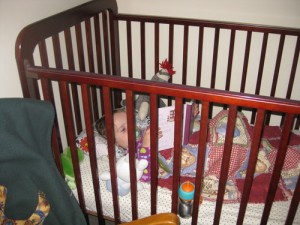
Harriet reading in bed. Yes, she still has a soother and sleeps in a crib. Do you want to make something of it?*
We do live a bookish life, reading our favourites over and over. We get about 15 books from the library every week, which mixes things up a bit. For some reason, we keep getting books about wolves though, over and over. Harriet keeps telling us things like, “The big bad wolf is in my room,” and then informs us that, “he’s teeny tiny.” Today she cried because we didn’t get a Katie Morag book from the library, and so we had to go back. (Actually, today was kind of annoying, but that’s another story…) Lately, she loves Little Bear, Charlie and Lola, Elephant and Piggie, Alfie and Annie Rose, Stella and Sam, Arthur and Franklin. Also Curious George, whose books are so long that reading them over and over gets to be a little tiresome. Don’t tell anyone I said so.
It’s Children’s Book Week this week at Canadian Bookshelf. First post went up today about the TD Grade One Giveaway, which is quite a cool program. Check the blog for new posts all week, including great ones by Sheree Fitch and Kristen den Hartog.
*”Do you want to make something of it?” is actually a quote from Judy Blume’s Superfudge, as delivered by Fudge’s best friend Daniel Menheim. As in, “I’m Daniel Manheim. I’m six. I live at 432 Vine Street. You want to make something of it?” Superfudge may be the only cultural reference point I allude to as often as Wayne’s World.





